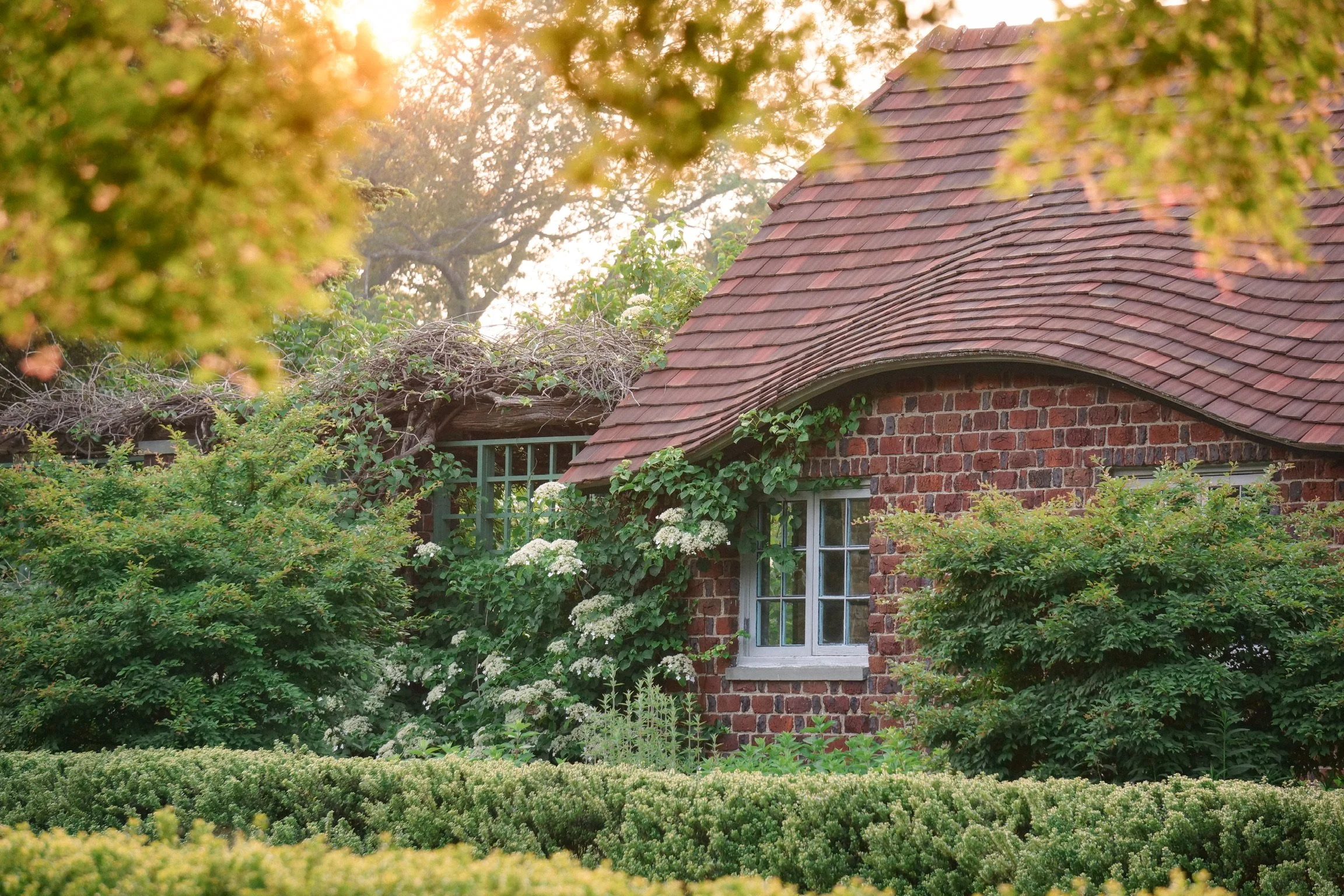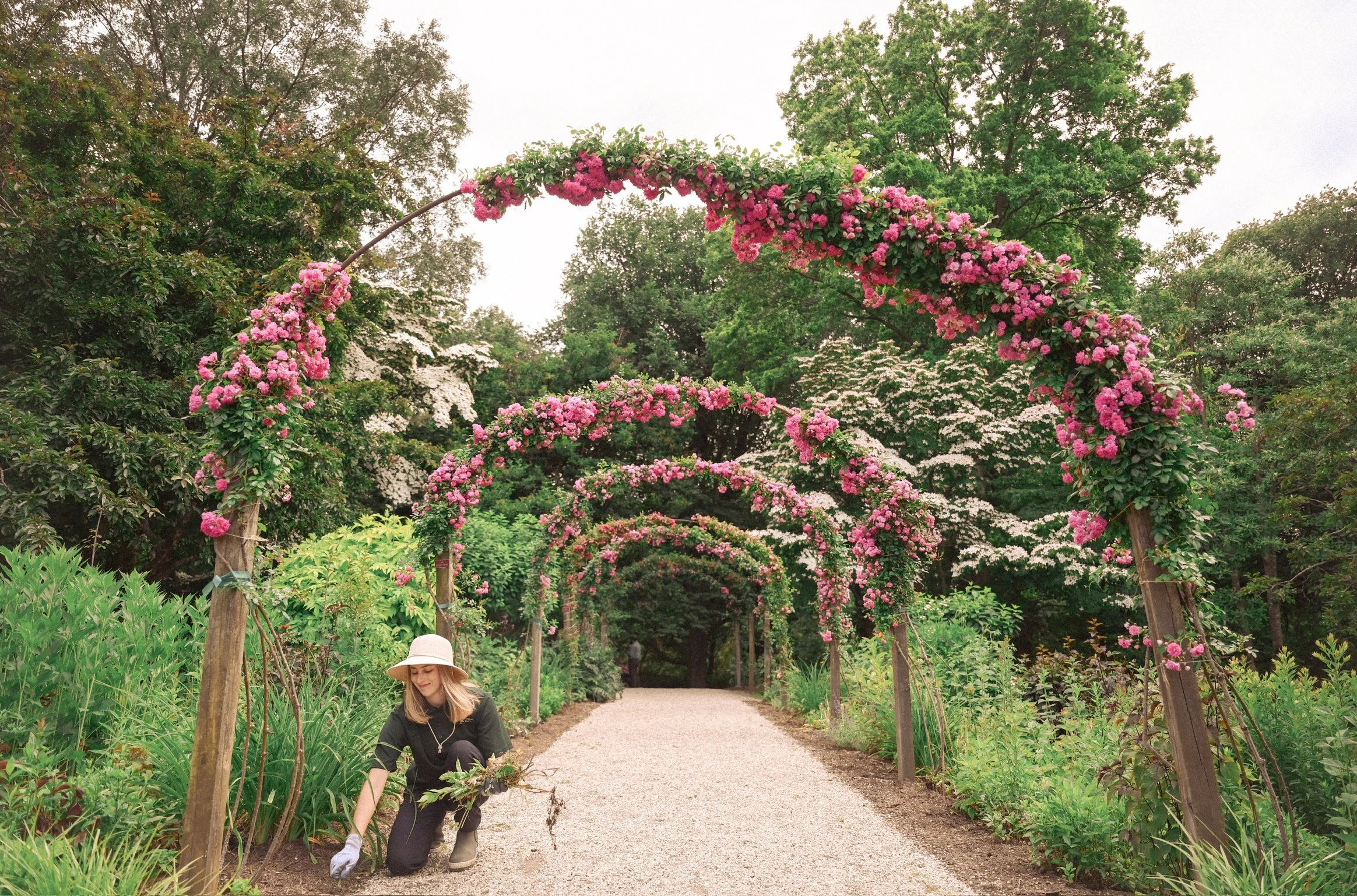GARDEN 002 | Garden Design 101: Finding Inspiration
Walking through the sunken garden at Planting Fields Arboretum, I’m inspired by the symmetry
Hello from the garden gate,
My first horticultural internship was at Planting Fields Arboretum. I’ll never forget my first day there. I was living on site, and after unpacking and setting up my room, golden hour was on the horizon. Golden hour is the time of day when the sun casts a beautiful warm, golden light across a landscape so I grabbed my camera and set out to explore.
One of the first photos I took upon arriving at Planting Fields Arboretum - The Tea Cottage
I was in awe of the diversity within the garden. There were areas with quintessential English formal lawns: pristine, manicured grass shaded by magnificent, wide-spread trees. There was a rose garden complete with a long walkway, framed by rambling roses trellised neatly into arches. Two cottages acted as design anchors within one area of the property. There were rhododendrons galore and mountain laurel dappled throughout the woods. There was a sunken garden with terraced beds overflowing with both annuals and perennials. There was even a garden where trees, shrubs, and other plants were sorted and planted alphabetically. There was a camellia greenhouse, home to a historic collection, and several other Gilded Age greenhouses bursting at the seams.
Thinning the perennial borders beneath the rose arbor was one of the many tasks I worked on during my internship at Planting Fields Arboretum.
There were so many incredible spaces to draw inspiration from. That summer shaped how I think about garden design to this day. If you’ve read the post where I walked through designing my own garden, you’ll know how much I value planning with intention. I try to consider how a space will be used, where it will be viewed from, and what role it will play in daily life long before I start planting.
Finding inspiration for garden (or even home) design might be my favorite part of the entire process. I love it because you can look anywhere. You might find a color scheme in a painting at an art museum. You might visit a garden and draw ideas from the way they organize space or select plants. You could design a whole landscape inspired by your favorite song or shaped to support an outdoor activity your family enjoys. You can flip through the pages of old library books or go for a hike through the woods. Inspiration is everywhere.
One of my favorite ways to find garden inspiration is to explore gardens from different parts of the world. Landscape design varies widely by culture. I personally love Japanese garden design. There are two main types of Japanese gardens: those meant to be strolled through, and those designed to be admired from a specific viewpoint. I tend to draw inspiration from the latter.
I find inspiration in gardens like the Shofusu Japanese Cultural Center, where designs are meant to be admired from specific viewpoints.
When designing my own garden, I think about where I’ll most often sit or stand to observe it. For me, that’s from the patio or the windows of my home. As a photographer, I also consider the angles I’ll want to capture it from. In many urban or suburban gardens, it’s worth thinking about what you might want to screen or hide, and where you might add privacy or create garden “zones.”
English cottage gardens, on the other hand, are incredibly practical. They’re densely packed with plants, many of which serve additional purposes like culinary or medicinal herbs or edible flowers, fruit and vegetables. In one book I read, I learned that fragrant plants were often placed near gates or along walkways so they’d brush against clothing and act as a natural perfume. These gardens also use tall plants like foxglove, delphinium, and hollyhock, so they can spill over fences and historic stone walls designed to keep curious rabbits out.
Golden hour in the rose garden at Planting Fields, where the white roses are beautifully framed by nepeta, offering a peaceful blend of colors and textures.
But some of the best garden inspiration comes from within. Your values and personal goals are powerful design tools.
If staying fit and active is a priority, you could carve out a space for yoga or outdoor workouts. If you're trying to eat fewer processed foods, growing fruit, vegetables, and herbs could inspire you to cook more meals at home.
If hospitality and quality time matter to you, design an area where your family can gather and enjoy being outside. If you love woodworking, pottery, painting, or reading, turn an old shed into a creative studio. Build yourself a backyard library. Create hidden garden nooks where you can escape into your books.
The pink playhouse (cottage) in the rose garden at Planting Fields Arboretum is a perfect example of a tucked-away feature, adding charm and whimsy to the space.
Inspiration is everywhere, but sometimes it helps to have a starting point. If you’re wondering what kind of garden might suit your life the best, I put together this quiz designed to guide you based on your personal goals, values, to bring clarity to what matters most to you.
Whatever it may be for you, looking to your values, your lifestyle and your goals is going to be the best place to draw garden inspiration from and it will be the most rewarding and sustainable way to design. By designing this way, you create a garden that works for you rather than a garden that you work on. Whatever you decide for your space should make you feel empowered to complete the project and it should align with what matters to you.
If there’s any way I can help guide you in your gardening journey, don’t hesitate to reach out.
Sincerely,
The Grower






